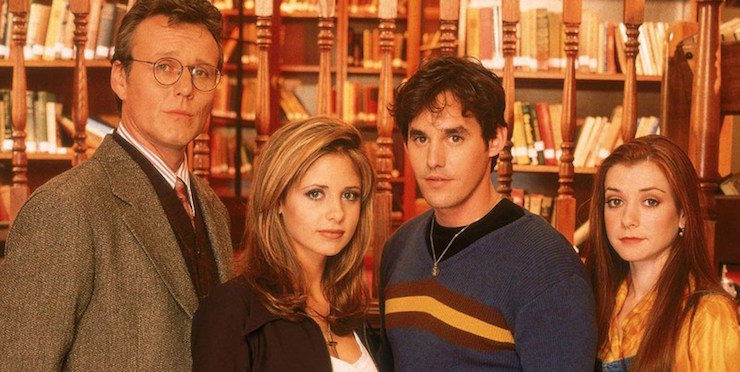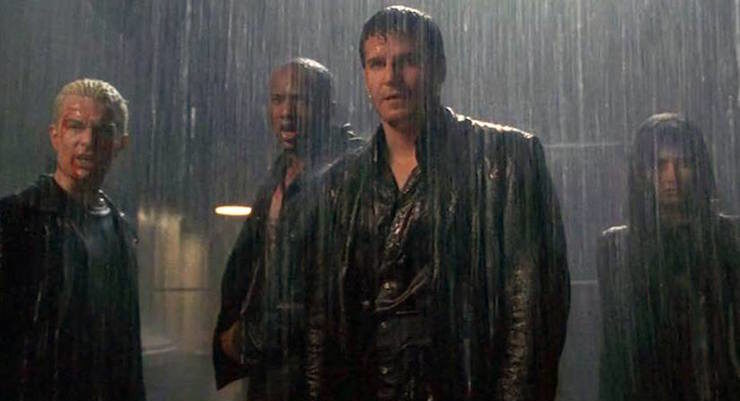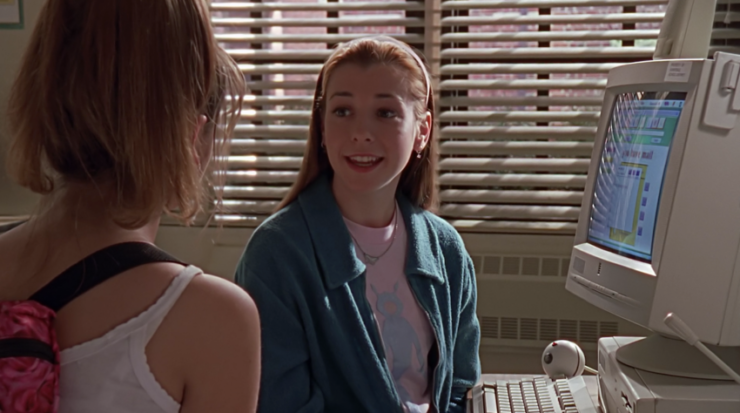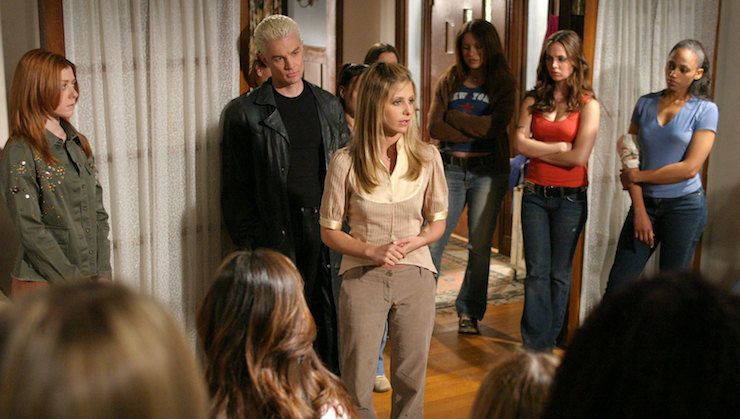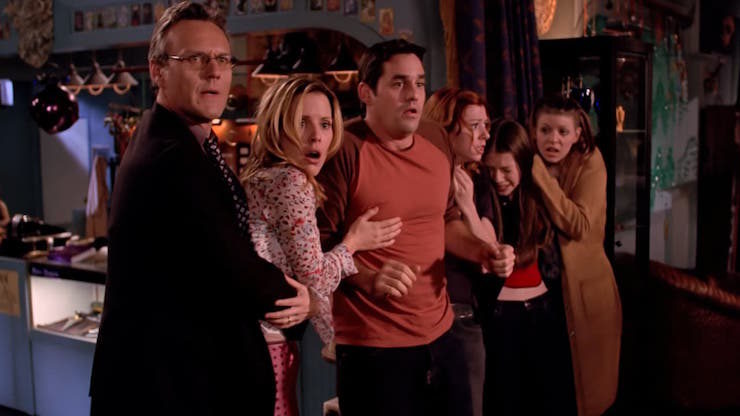When the news broke that Buffy the Vampire Slayer would be coming back to TV in some form, it was… confusing. In a single Hollywood Reporter article, the new show was described as a “reboot,” a “new take,” an “adaptation,” and a show that would “build on the mythology of the original.”
Three things seem certain: Buffy creator Joss Whedon is executive producing the show; Monica Owusu-Breen will write and serve as showrunner; the Slayer will be black.
Reactions to the idea of Buffy coming back in some unknown form ranged from excitement to trepidation to dread. Reboot fatigue is real; nostalgia only gets you so far; is it possible for something to be so iconic as to be un-repeatable? The overall sense among fans seemed to be that almost no one wanted a Buffy do-over… but given the Buffyverse’s potential for new stories, people were tentatively intrigued by the idea of a continuation.
Last week, Owusu-Breen posted a short note on Twitter:
— m.o.b. (@monicabreen) July 26, 2018
This statement, short as it is, is heartfelt, smart, touching, and written by someone who clearly understands the Buffy fandom, and the fears people have. It did a lot to assuage those fears by saying one simple thing: “So maybe, it could be time to meet a new Slayer…”
Taking this into account, we’re looking not at a reboot, but a continuation. A revival. But that single fact raises a ton of questions!
1. Will the changed TV landscape mean a more “mature” show? Will it be on cable or streaming?
The new show will reportedly be shopped around to networks and streaming services in late summer, so we have no idea yet where—or how—it will air. Original Buffy had the once-normal 22 episodes per season, with monster-of-the-week episodes trading off with bigger narrative arcs. There’s not really room in today’s TV landscape for that kind of storytelling; the closest comparisons in genre TV are probably the DC shows on The CW, which still have the luxury of filler episodes and slow narrative builds. But they can feel draggy and overlong, at least in comparison with fleeter, sharper storytelling like what you find in something like Syfy’s The Magicians (which has more than earned its Buffy comparisons at this point).
A new Slayer show is much more likely to have a short season, but it depends on what kind of show this Buffy wants to be—and where it airs. A full-season mid-level show, like the many superhero shows on The CW? A 10-episode Netflix or Hulu series that arrives all at once, ready for bingeing? A darker, more grown-up Buffy on HBO or Starz? A Buffy with a lot of freedom on Syfy?
If there’s one thing I don’t want, it’s a Game of Thrones-influenced Buffy. A show about fighting monsters has an innate level of violence, but that doesn’t mean it has to be over-the-top dark, or brutal, or gory. It doesn’t have to chase the vampire bunny down the grimdark rabbit hole. It does have to find its own way to fit into a TV landscape so saturated with smart writing and clever narratives that we’re all often complaining about how much good stuff there is to watch.
That’s a challenge every show faces, sure. But not with the weight of Buffy’s world on its shoulders.
2. What about the comics?
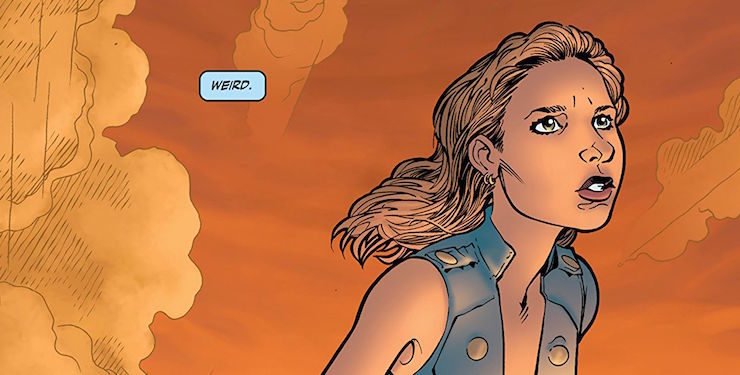
TV Buffy ended with season 7, but the comics eventually picked up right where the show left off. Season 8 is an over-the-top, giant-goddess-featuring, bugs-flying-ships, everyone-can-fly, Warren-lives-without-skin, world-changing, huge-scale story—the kind budgets would never let Whedon tell on TV. Angel and Buffy literally fuck a universe into existence. Shit gets, to put it extremely mildly, weird.
Following the TV finale, the world’s very different. Everyone knows about Slayers and supernatural creatures. People take sides. Harmony gets a reality show. Magic goes away, magic comes back, the narrative crosses over with characters from Angel; even poor Fred Burkle, whose death still makes me weep, reappears. Some of it is great and some of it is slightly dodgy. It’s a lot of mythology for a baby show.
The Buffyverse could pull a Star Wars and negate parts of its existing canon. There are other options: the new Slayer could be in a parallel universe, on a different world, in a different timeline, or the result of a magical reset. But it would certainly simplify things if they decided upfront that the new show will only use the most familiar parts of sprawling mythology.
There is, however, one comics tidbit I’d love to see carry over into the show: for very complicated reasons, and thanks to a pieces-of-his-soul search that doesn’t sound at all like a Horcrux hunt, Giles wound up in the body of his teenage self. But he’s still Giles, with all his memories and knowledge. He’s just Young Giles.
Find the right actor to carry this off and I would pay good money to watch said actor convince me he is Anthony Stewart Head trapped in the body of a 20ish-year-old.
3. Where are the original Scoobies?
I don’t want a new Slayer to be beholden to the past. But in the present, the original Scoobies are presumably still out there, still fighting the good fight in some way. One doesn’t retire from being a witch or a vampire; Dawn was still a kid when the show ended; Buffy wouldn’t have left all those baby Slayers to fend for themselves. (Give the girl a nice vacation first, though.)
Hopefully Whedon has learned from his “oh Buffy’s over here doing this thing” mistakes, which is to say: that time Angel and Spike “saw” Buffy partying in Rome was deeply unconvincing. (That got neatly retconned in the comics: it was a decoy Buffy anyway!) If they’re not dead, and we’re not in a different dimension/timeline/hellworld, the original Scoobs need to be accounted for in some way. Leaving aside the Giles question, Alyson Hannigan’s Willow seems the most likely to appear—maybe leading a new coven? (Let us not speak of Xander. We shall not miss him.) Dawn—who’s been a giant and a centaur in comics continuity—is also a likely cameo candidate. I’d kind of love to see her grown up into a Watcher. Who knows better how to deal with a Slayer?
Do we want them on the show, though? Or do we want a clean slate? This revival is being pitched as an “inclusive” version, which is fantastic; original Buffy was not the greatest on the representation front, short of Robin Wood—who I would also love to see—and a few of the Potentials. The presence of Boy Wonder Giles and a few cameos would be sufficient.
4. Will the show account for/include real-world events or is this an alternate timeline created by the end of Buffy and Angel?
Let’s say the comics are stricken from canon and we’re only dealing with the world of the two main shows. That still leaves a lot to account for: to start with, there’s the rubble where Sunnydale once was, the sudden awakening of hundreds or thousands of magically powerful girls and women, and the fact that Los Angeles was, circa 2004, being overrun by a supernatural army, dragon included. (And then, in the Angel comics, it went to hell. Literally.)
Neither show engaged much with the real world; they were dealing with the problems within their own spheres. But a new show could look outward—it could take place outside of California; it could exist in a world shaped by the last few presidential elections; it could be aware of conflicts and wars beyond those with demonkind. Or it could take place in a different timeline, one shaped by the end of both shows—one where everything, from international conflict to the internet, was reshaped by the world’s knowledge of the supernatural.
Most SFF shows are either set in a different century, avoid current events entirely, or have their own versions of the world with different organizations, leaders, and threats. For the most part, they also avoid dealing with the question of the internet, which often rings false; people would 100% be posting selfies with Supergirl, and if Slayers become household knowledge, it’ll happen to them too. Supervillains would be totally into social media. People would write blog posts about the actions of Slayers and supers (like Iris West-Allen still does, very occasionally, on The Flash). Little sisters would get in big trouble for posting training footage to their Instagram stories.
5. How different will the fandom/cultural conversation about Buffy be?
Buffy was always a show that inspired a lot of intense discussion, but that dialogue was hugely different 20 years ago. Then, we talked on forums, or on the dearly departed Buffy listserv—a deep well of conversation where every theory was considered, every meaningful item on the show was digitally claimed by someone who became its “Keeper,” and someone, somehow, got their hands on (and shared) a VHS copy of “Earshot” when it was pulled after Columbine.
But fandom is different now, because the internet is different now. Heavy geek-outs that once happened between friends or over email are everywhere; the analysis is more public, more persistent, more dominant, and harder to avoid. Whether or not the show takes that into consideration, fans will be watching differently. And it’s hard, in some ways, to think about that—to think about the ugly side of Twitter discourse turning toward such a beloved story. To drag Buffy, flaws and all, into the kind of spotlight glaring on Star Wars, and on Harry Potter. I love talking about Buffy, analyzing Buffy, picking apart its flaws, appreciating its power, tearing up at the end of “Chosen.” But this conversation is going to be unlike any we had before.
6. This brings me to my biggest question: How will this new show grapple with the vital import of the series finale?
Buffy began as the one special girl—the one girl in all the world with the power to fight the darkness. And we’ve been hearing this story ever since (and long before). The one-special-girl narrative has dominated so much coming-of-age science fiction and fantasy that it’s getting hard for me to read, because there’s a weird undercurrent of sly misogyny to the entire idea that there can be only one. We see it in stories in which only one girl has the magic/power/strength/gifts to stop the bad guy/world-ending disaster/poorly thought-out social experiment. We see it in stories that only allow room for one female character among their all-male teams.
When there’s only one, women are socialized to devalue each other. To all feel like we have to be the one special girl. To see that the only way to succeed is to be the only option. To be “one of the guys.” To see other women as competition. When there’s only one girl with power, most of the power is still elsewhere.
Buy the Book


Worlds Seen in Passing: Ten Years of Tor.com Short Fiction
The end of Buffy recognized and dismantled this concept. Over seven seasons, Buffy slowly took apart the notion that there could be only one. She worked with her friends, leaning on their strengths; she and Kendra and Faith learned, hard though it was, to trust each other, to accept their differences. Some fights, Buffy had to win alone. (Her showdown with Angel in “Becoming, Part II” is a thing of beauty.) But as the show went on and the battles got bigger, Buffy didn’t just need a team. She needed an army. So she rejected the patriarchal Slayer mythology, and she chose to share—understanding that the only way forward was to empower as many other girls as possible.
This new Buffy has to understand that there isn’t a single chosen one anymore. There can’t be; another “only one girl” narrative would fly in the face of everything that finale meant. It won’t necessarily be easy to re-imagine a world full of Slayers; season 7 definitely struggled with a world full of Potentials. I hope Owusu-Breen is up to the challenge, and I hope she builds this new series on the promise of “Chosen.”
But there’s one factor that worries me:
BONUS QUESTION: How does this connect—if at all—to Kiersten White’s upcoming novel, Slayer?
Last year, a different new Slayer was announced: the heroine of YA author Kiersten White’s upcoming series, the first book of which, simply titled Slayer, is due out in the spring. The book’s description teases a Watcher’s Academy (the titular Slayer, Nina, and her twin sister attend), a rebuilt Watcher’s Council, and—frustratingly—the twist that Nina is “the last Slayer ever. Period.”
Setting aside that Melaka Fray has already been established as the last Slayer, hundreds of years in the future: Why? In the comics, magic has gone through some things, and power’s never been consistent. The world in this novel is probably due for another kind of cosmic reset; maybe the powers that be are changing the playbook and doling out power in some new way. I’m not going to judge the book on cover copy and one short excerpt, but it does make me nervous how the Buffy mythology returns to these ideas—there’s only one, or that she’s the last one. And given the timing of this book—it had to be in the works while this new series was being dreamt up—I wonder if they’re connected in any way.
There’s so much to think about, and to consider, about whatever form the Slayer revival takes, and a billion questions that I haven’t even gotten to: How unprepared were the Watchers, however many of them were left after the Council blew up, when all the Potentials were called at once? Did anyone ever have time to mourn Anya? Did Glory’s attempts to open a hell dimension at the end of season 5 let anything else loose, like, say, the Mayor, who laid low before re-entering politics?
But what I think about the most is how Buffy, like Harry Potter, was one of the stories that took us from the ‘90s into the new millennium—both in the world at large, as we fretted about Y2K and joked about what we were supposed to call the aughts, and online, as the internet became normalized, a constant part of everyday life for everyone. Everything is of its era, but some things are of more defining eras. The way we watched Buffy, talked about Buffy; the way Buffy belongs to those who watched it as teens as much as it does to those who watched it as adults; the way it represents a flawed, un-intersectional kind of feminism that was nonetheless really needed at its time; the way a show, then, could survive its imperfections and still be iconic—these things work differently now. Buffy herself would be different now; she’d be in her late 30s. I like to imagine she’d still be fighting.
I like to imagine she always is. And I like even more to imagine that this new Slayer will fight even harder, for even more people, in a world that’s grown even uglier since Buffy’s day.
I can’t wait to meet her.
Molly Templeton is behind on her 20-years-later Buffy rewatch, but obviously now is the time to pick that back up! You can also find her on Twitter.












